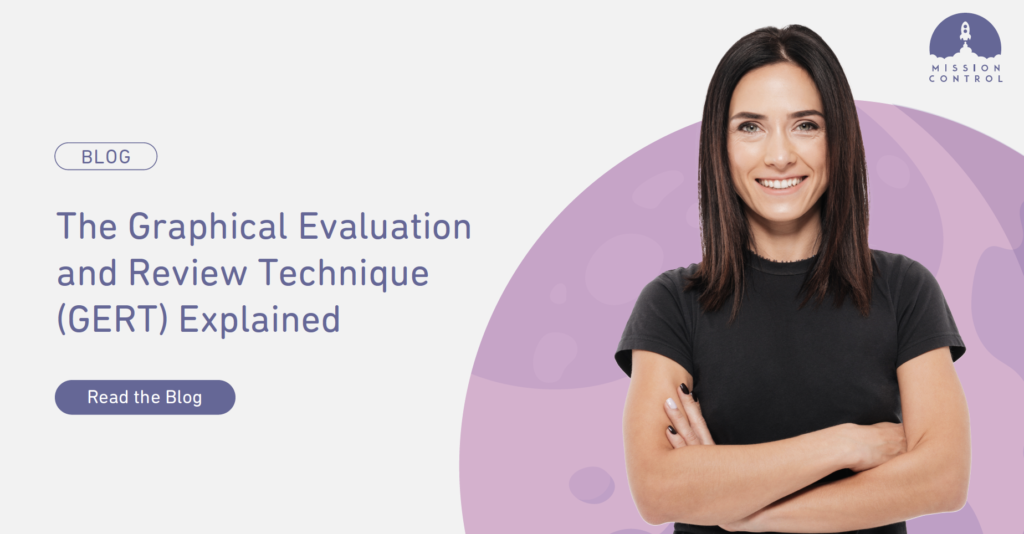Estimating how long project activities will take, forms a crucial part of any project planning process. Once you know the activities you must complete to successfully deliver your client’s requirements, you need to determine how long each activity will take and create a project schedule.
This article introduces the Graphical Evaluation and Review Technique (GERT), a reliable tool for creating accurate activity duration estimates.
We explain:
What is the Graphical Evaluation and Review Technique (GERT)
Advantages and disadvantages of GERT in project management
GERT vs. other network diagrams
The use of Graphical Evaluation and Review Technique (GERT) in project management
What is the Graphical Evaluation and Review Technique (GERT)
Put simply, GERT is a methodology used to estimate how long a project will take. The approach is used across various industries and areas of work, but is especially popular within project management. GERT is a highly preferred estimation tool that allows for probabilistic treatment of both network logic and activity duration estimates. The approach assumes that you can’t be sure what the outcome of future events will be, but you can infer whether or not they are likely to happen an act based on this probability.
GERT can be particularly effective when you want to estimate the duration of project activities that teams will only perform in part and those that will be performed more than once (loop). These activities are usually interrelated and can be performed concurrently, significantly reducing the project development time.
For example, on an office block construction project, technicians may install the internet wiring for each floor as it’s being completed, instead of waiting for the completion of the entire building. Since the technicians will perform this activity several times, using GERT will enable you to calculate how long the activity will take throughout the project.
The GERT approach uses activity-on-arrow notation only. This means that you describe each activity on an arrow. Then you use the nodes to connect activities and determine the type and conditions of relations between them.
This visualization enables project managers to understand how project activities interact and how to apply process iteration to accelerate product development processes.
Advantages and Disadvantages of GERT in Project Management
Implementing the GERT network or techniques comes with its own set of pros and cons.
First, the pros. The GERT model:
- Allows loops between tasks and incorporates probabilistic nodes, thus considering the degree of uncertainty in the projects.
- Breaks down a complex project into a simpler network of interrelated activities. This enables the project manager to organize the project schedule effectively and manage it efficiently.
- Is the best method to visualize and specify data requirements when modeling, analyzing, and designing diverse projects.
- Serves as a reliable communication tool among different project stakeholders as it’s visible to everyone.
Disadvantages of GERT include:
- To model the GERT system, you’re required to use the Monte Carlo simulation, a complex program that can be pretty challenging to use.
- GERT is still relatively new in project management, and teams are still learning how to maximize its use.
GERT vs. Other Network Diagrams
Most project managers use the Critical Path Method (CPM) and Program Evaluation and Review Technique (PERT) networking techniques to plan various project activities. While popular, these techniques also have some inherent limitations that make them unreliable. The main cons are:
- There are no alternative paths. Therefore all activities have to be performed.
- There are no loops, so it’s impossible to repeat an activity. Teams must add the next similar activity.
- There is no scaling. You can’t replace some detailed group of activities with the one summary task.
Though GERT is less common than CPM and PERT, it addresses most of the above limitations. GERT:
- Allows loops between tasks.
- Includes features such as stochastic models, feedback loops, multiple outcomes, and repeat events.
The Use of Graphical Evaluation and Review Technique (GERT) in Project Management
A project manager aims to plan, manage and utilize resources effectively throughout the life of a project. Project managers can achieve predetermined scope, cost, time, quality, and customer satisfaction using modern management techniques.
Despite advances in project management today, most projects still grapple with cost and time over-runs which increases as the projects become more complex. For instance, according to a study by McKinsey and the University of Oxford, on average, large IT projects run 45% over budget and 7% over time.
Project managers need proper project duration estimates to ensure that projects stay on track and increase speed-to-market.
Project managers can rely on GERT for project planning, especially for complex projects that require a higher degree of pre-planning and rescheduling and with activities loops. It helps teams visualize the activities they need to complete over a project’s life cycle. Project teams can also gain crucial insights like task duration, sequence, and dependency.
Since many complex projects involve probabilistic occurrences, false starts, activity repetition, and multiple outcomes, GERT is an ideal tool for project managers who desire better time estimates.
Furthermore, you can extend the capabilities of your GERT network diagram when you implement a project management tool such as Mission Control.
Mission Control has a Gantt chart feature that lets you visualize all your project activities and their interdependencies. This chart can help you identify loops that you can use in your GERT diagram.
Once you analyze your GERT diagram and identify how the project activities interact, you can use your Kanban to reschedule and reassign tasks accordingly.
Contact us today for a demo of how Mission Control can help your organization plan its projects better.




